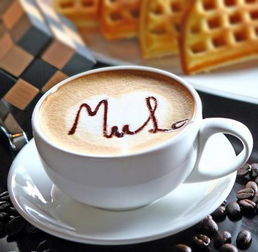The historical origin and development of cappuccino coffee
At the beginning of the 20th century, when the Italian Azibucha invented the steam pressure coffee machine, he also developed cappuccino coffee. Cappuccino is an Italian coffee mixed with the same amount of Italian espresso and steamed milk. At this time, the color of coffee is like a cappuccino monk covering a dark brown coat with a headscarf, hence the name caffeine. The traditional cappuccino is 1/3 espresso, 1/3 steamed milk and 1/3 foamed milk. The full-bodied taste of espresso, accompanied by lubricated foam; it has a hint of essence and dew. Sprinkled with foamed milk with cinnamon powder, mixed with the aroma of bottom-up Italian coffee, the new generation of coffee is fascinated by it. It has an irresistible unique charm, at first it smells good, when you drink it, you can feel the sweetness and softness of a large number of milk bubbles, and the second taste can really taste the original bitterness and richness of coffee beans. finally, when the taste stays in the mouth, you will feel more mellow and meaningful. Don't you think it's amazing that a kind of coffee can have many different unique flavors? The first mouthful always makes people feel bitter and sour, a large number of bubbles are like young people's light life, and the bursting of bubbles and that little bitterness are like a conflict between dreams and reality. Finally, after tasting the joys and sorrows of life, the sweetness of life is intoxicating. This is like a teenager in adolescence. After enjoying a childish and wonderful time, they have to face the impact of stepping into the adult world and really taste the original taste of life-in addition to sweetness and bitterness.

The origin of cappuccino FanzGeorgeKolschitsky of Vienna is the founder of CafeLatte with milk and coffee. Both drinks are made from coffee and milk, but cappuccino has a more knowledgeable origin and has always been the best material for the study of character changes in Europe and the United States. The history of the word Cappuccino: the monks of the St. Franciscan Church (Capuchin), founded five years later in 1525, all wore brown robes and pointed hats. When the St. Franciscan Church spread to Italy, the locals thought the monks' clothes were very special, so they gave them the name Cappuccino. The Italian word refers to the loose robes and small pointed hats worn by monks, derived from the Italian word "headscarf" or Cappuccio. However, Old Yi loved coffee and found that when espresso, milk and milk foam were mixed, the color was like the dark brown robe worn by monks, so he came up with a drink with coffee and sharp milk bubbles, which was named Cappuccino. The word was first used in English in 1948, when a report in San Francisco first introduced cappuccino beverages, and it was not until 1990 that it became a familiar coffee drink. It should be possible to say that the word Cappuccino coffee comes from the St. Franciscan Church (Capuchin) and the Italian headscarf (Cappucio). It is believed that the original word makers of Cappuccino never dreamed that the monks' robes would eventually become the name of a coffee drink. Cappuccino is also related to the name of a monkey. There is a small monkey in Africa with a black cone-shaped hair on its head, much like a pointed hat on a St. Franciscan robe, hence the name Capuchin, which was first used by the British in 1785. The word Capuchin has generated coffee drink names and monkey names hundreds of years later, which has always been an interesting story for literati. Dry cappuccino and wet cappuccino do you know that cappuccino can be dry or wet? The so-called dry cappuccino (DryCappuccino) refers to the conditioning method with more milk bubbles and less milk. it tastes stronger than milk and is suitable for people with heavy taste. When it comes to wet cappuccino (WetCappuccino), it refers to the practice of fewer milk bubbles and more milk, with milk fragrance overshadowing the thick coffee flavor, which is suitable for those with light taste. The flavor of the wet cappuccino is similar to that of the popular latte. Generally speaking, the taste of cappuccino is heavier than latte. If you have a heavy taste, you might as well order cappuccino or dry cappuccino. If you are not used to the heavy smell of coffee, you can order latte or wet cappuccino. Cappuccino coffee is made on the basis of Italian espresso and a thick layer of foaming milk is made into cappuccino. The quality of espresso can be seen in milk and foam, but it is still an important factor in determining the taste of cappuccino. Pour the partially skimmed milk into a pot, then use a foamer to foam and inflate the milk, and let the milk be as uniform as whipped cream without burning. The cappuccino coffee cup should be warm or the milk foam will spread. You can usually put these cups on the top of the coffee maker to keep warm. Pour the milk and foam on top of the espresso and form a natural layer, just like wrapping the coffee below. Note that the brewed Italian coffee is about five cents full, and the hot milk that has been foamed is about eight cents full. Finally, you can sprinkle a little cinnamon or chocolate powder and pour the rest of the milk together to make a delicious cappuccino. Blue Mountain Coffee (BLUEMOUNTAIN) is produced in the Blue Mountains of Jamaica above 2500 feet above sea level, is a kind of slightly sour, supple, sweet, delicate flavor of coffee; pure Blue Mountain coffee taste, light flavor, but taste is very mellow and delicate; with aristocratic taste, is the best coffee.
Important Notice :
前街咖啡 FrontStreet Coffee has moved to new addredd:
FrontStreet Coffee Address: 315,Donghua East Road,GuangZhou
Tel:020 38364473
- Prev

A short story about coffee that you have never heard of
1. Coffee spa in Japan the spa, located in Hakone, Japan, is a professional spa where customers can be bathed in a variety of pleasant sticky liquids, such as wine, chocolate, green tea and coffee. The ticket price for the coffee bath is 2800 yen, where visitors can pour coffee on themselves and then go to the opposite ramen bathroom in noodles.
- Next

The historical and cultural origin and making of latte
Latte is a classic blend of Italian espresso and milk. Italians also like lattes as breakfast drinks. In the Italian kitchen in the morning, coffee and milk are usually brewed on the sunlit stove. Italians who drink lattes like milk rather than espresso, and only espresso can give it to ordinary people.
Related
- How did the Salvadoran coffee industry develop in Central America?
- What exactly does the golden cup extraction of coffee mean?
- The Origin of Coffee flower
- [2023 Starbucks World Earth Day] there are more meaningful things besides free Starbucks coffee!
- What kind of coffee is there in Spain? 9 Flavors of Spanish Coffee
- Aromatic African coffee| Kenya's coffee culture and historical production area
- Liberica Coffee Bean knowledge: the characteristics of Liberian Coffee beans of the three original species of Coffee beans
- The origin and formula of Spanish latte introduces the taste characteristics of Bombon coffee in Valencia, Spain.
- How to adjust the solution of over-extracted coffee
- What is the tasting period of coffee beans? What is the period of coffee and beans? How should coffee wake up and raise beans?

